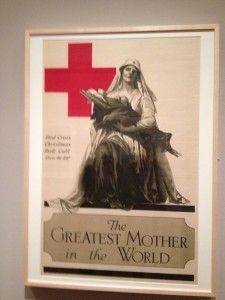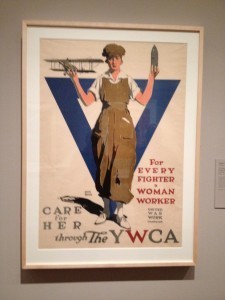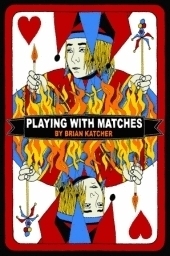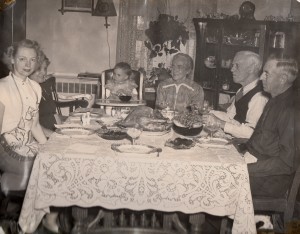Lea Wait's Blog, page 304
December 5, 2014
Weekend Update: December 6-7, 2014
 Next week at Maine Crime Writers there will be posts by Susan Vaughan (Monday), Lea Wait (Tuesday), Barb Ross (Wednesday), Al Lamanda (Thursday), and John Clark (Friday).
Next week at Maine Crime Writers there will be posts by Susan Vaughan (Monday), Lea Wait (Tuesday), Barb Ross (Wednesday), Al Lamanda (Thursday), and John Clark (Friday).
In the news department, here’s what’s happening with some of us who blog regularly at Maine Crime Writers:
From Maine Crime Writers: We love all Maine bookstores and want to alert you that this Saturday is Take Your Child to a Bookstore Day. Here’s what our friends at Longfellow Books in Portland are doing to celebrate:
This Saturday marks the fifth annual Take Your Child to a Bookstore Day and Longfellow Books will, yet again, be doing our part to encourage the younger generation in Portland to fall in love with books by letting them all pick out a FREE book. That’s right, every child under 12 who stops by Saturday with a grown-up gets to choose a free book (up to a $10 value). This day is one of our favorites of the year – the store is packed with kids checking out books, sharing their favorites with friends, families enjoying something in December that doesn’t cost more money and mostly, lots of smiles and gratitude. See you Saturday, readers…
 We hope you’ll follow our blogs this month as we share the books we most want to receive, and the ones we’re planning to give. And that you will share your choices with us, so we can do a “Our Reader’s Choice” post to celebrate you. What book captivated you this year? What book are you most looking forward to reading?
We hope you’ll follow our blogs this month as we share the books we most want to receive, and the ones we’re planning to give. And that you will share your choices with us, so we can do a “Our Reader’s Choice” post to celebrate you. What book captivated you this year? What book are you most looking forward to reading?
Bored by the usual holiday tree? Can’t get to Kaitlyn’s Christmas Tree farm to cut your own? Is your house too full of books? Well here are some ideas for using those books to make a tree: http://www.themarysue.com/12-christmas-trees-made-out-of-books/
From Kathy Lynn Emerson: If you happen to be reading this in the UK, Murder in the Queen’s Wardrobe, the first book in my Mistress Jaffrey Mystery series (historical mysteries set in the 16th century), hit stores there at the end of November. It will be available in the U.S. in March. I mention this now because there is one chapter in which Rosamond’s estranged husband, Rob Jaffrey, in Moscow at Christmas time, reminisces about traditional Yuletide celebrations back home in Kent.
An invitation to readers of this blog: Do you have news relating to Maine, Crime, or Writing? We’d love to hear from you. Just comment below to share. Don’t forget that comments are entered for a chance to win our wonderful basket of books and the very special moose and lobster cookie cutters.
And a reminder: If your library, school, or organization is looking for a speaker, we are often available to talk about the writing process, research, where we get our ideas, and other mysteries of the business. Contact Kate Flora: mailto: kateflora@gmail.com
December 4, 2014
Camden’s Christmas By The Sea
Vicki Doudera here, ready to celebrate the season with our 28th Annual Christmas by the Sea Celebration, which gets underway today here in Midcoast Maine.
If you want to get in the holiday spirit, it would be an absolute crime to skip this weekend-long event. There are loads of fun adult and family-friendly activities, and many of them are free. Take it from me, your trusty holiday girl-in-the-know – these are the highlights you won’t want to miss.

1. Don’t Miss the Kickoff Parade.
Literally… don’t miss it… because if you are not on Main Street in Camden at 6 pm TONIGHT, you very well could! The brainchild of Camden and Rockport’s Cub Scout Pack 200, the parade has grown from one float (me and lots of cub scouts and a few Dads throwing candy) to a larger, brighter affair. But while the parade has grown tremendously over the past few decades, it’s not quite the size of Macy’s. So if you dip inside a store, be sure to keep an eye on the time.
2. Take the Walk Through Bethlehem.
Unless you really, truly dislike the religious underpinnings of Christmas, be sure to head to the Chestnut Street Baptist Church anytime from 6:30 to 9 on Friday or Saturday to see this amazing live theatre event. You’ll sing carols in the church first and then be led with other members of your “tribe” through the church’s rooms to experience the story of Jesus’ birth. Very moving and an amazing volunteer effort.
3. Moo with the Belties at Aldemere Farm.

From 9 to 12 on Saturday, you can visit Aldemere Farm in Rockport, have a cup of cider, make a craft, and visit with Maine’s cutest cows. Don’t ask my why this is a Christmas-y event but there is something about being around farm animals that brings to mind stables in Bethlehem.
4. Browse a Fair… or Two…or Three!
Holiday fairs abound on Saturday, from one at the First Congregational Church of Camden (9 to 2) featuring local artisans and their work, to the Holly Berry Fair in Rockport’s Opera House, hosted by the Rockport Garden Club (8 to 1) to the St. Thomas Episcopal Church Fair (9 to 2.) These fairs are fun to browse and are great places to find unusual gifts.
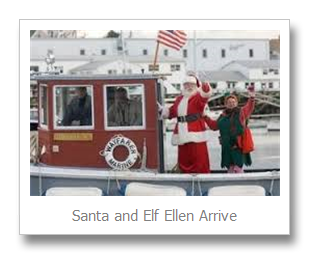
5. See Santa Come into the Harbor by Boat.
The jolly man himself and his cheery Elf Ellen will motor into the harbor at noon on Saturday to hand out candy canes and read a story at the Camden Public Library. Such fun to watch the happy little faces see St. Nick!
6. Hear the Christmas Bells like You Never Have.
At 4 pm on Saturday, various bell ringing groups combine in a Ringing in the Season concert that will put you in the holiday spirit for sure. Held at the First Congregational Church of Camden, this event is free but a goodwill offering for a local nonprofit is taken.
7. Tour a Historic Home or Two.
Tour a magnificent cottage home decorated for the holidays in Camden, or a historic Thomaston home spruced up for Christmas. Held both Friday and Saturday. Camden’s is sponsored by the Camden Garden Club, while Thomaston’s Home for the Holidays House Tour is put on by the Thomaston Historical Society.
Many more activities are listed online at the Penobscot Bay Chamber’s website. Whatever you do — have a wonderful weekend and look for me out and about!
December 3, 2014
Something About Me . . . and Peter Pan
 Kaitlyn Dunnett, aka Kathy Lynn Emerson here. So—how many of you are going to watch the live production of Peter Pan tonight on NBC? I wouldn’t miss it for the world. You see, Peter Pan and I go way back—more than sixty years. The Disney film came out in 1953, when I was six, but the night I’ll never forget was the first television broadcast of the musical play starring Mary Martin as Peter.
Kaitlyn Dunnett, aka Kathy Lynn Emerson here. So—how many of you are going to watch the live production of Peter Pan tonight on NBC? I wouldn’t miss it for the world. You see, Peter Pan and I go way back—more than sixty years. The Disney film came out in 1953, when I was six, but the night I’ll never forget was the first television broadcast of the musical play starring Mary Martin as Peter.
There I was, age eight, already in my jammies, sitting cross-legged on the floor in front of our black and white television set. I was so excited. You think the hoopla over this new production is something? It’s nothing compared to the publicity generated back in 1955.
The show came on as scheduled. I sat there, eyes glued to the screen, enraptured. And then, without warning, the picture vanished.
There was something wrong with our TV! It had stopped working!
Eight-year-old kids do not react well to having the treat they’ve looked forward to for weeks taken away from them!!!!
 Fortunately, my parents understood that this was a crisis. Mom made a quick phone call. Then they bundled me into the car, still in my pajamas, and drove me to my best friend Patty’s house, getting me there so fast that I probably missed no more than ten minutes of the production.
Fortunately, my parents understood that this was a crisis. Mom made a quick phone call. Then they bundled me into the car, still in my pajamas, and drove me to my best friend Patty’s house, getting me there so fast that I probably missed no more than ten minutes of the production.
I’ve seen many versions of Peter Pan since then, everything from a PTA-sponsored amateur production to movies like Hook and and the Syfy channel’s Neverland. I still love it. I have the VHS edition of the 1960 Mary Martin production. By that time, the third broadcast, it was filmed in color. When I was still a kid, I acquired an LP of an earlier (1950) musical version of the play starring Jean Arthur as Peter and Boris Karloff as Captain Hook. This recording featured only five songs, but they were written by Leonard Bernstein, and it included all the dialog—no wonder I’m so fond of listening to audiobooks. I have the DVD of the Disney classic, and the original comic book, and three Little Golden Books, each telling part of the story. The Disney version, of course, commissioned its own songs.
 I have a copy of the J. M. Barrie play, written in 1904. It’s much darker than the musical versions. I’ve also seen Finding Neverland, although I wasn’t that impressed with it, and the 2003 film with a boy playing Peter. Traditionally, the role is played by a woman. Another usual practice in the stage play is for the same actor to play both Mr. Darling and Captain Hook—that adds another dimension to the story, don’t you think? But tonight, Christopher Walken is just Hook and the actor playing Mr. Darling is doubling as Smee. I don’t know what that’s supposed to mean. Another new wrinkle is that Nana, the dog, will be played by a real dog instead of an actor in a dog suit.
I have a copy of the J. M. Barrie play, written in 1904. It’s much darker than the musical versions. I’ve also seen Finding Neverland, although I wasn’t that impressed with it, and the 2003 film with a boy playing Peter. Traditionally, the role is played by a woman. Another usual practice in the stage play is for the same actor to play both Mr. Darling and Captain Hook—that adds another dimension to the story, don’t you think? But tonight, Christopher Walken is just Hook and the actor playing Mr. Darling is doubling as Smee. I don’t know what that’s supposed to mean. Another new wrinkle is that Nana, the dog, will be played by a real dog instead of an actor in a dog suit.
 There’s a new theatrical release titled Pan due out next year. As in Neverland, new characters are added, Peter is played by a real boy, and an attempt is made to explain how he got to Neverland in the first place. Why the fascination with the story of Peter Pan? There are lots of theories. Some of them are discussed in the blog found at http://hellogiggles.com/ways-peter-pan-ahead-time where gender issues and the concerns about stereotyping Native Americans are also raised. It makes for interesting reading, but I think there may be a simpler answer. I suspect that there is a little of the child left in all of us, a kid who still does not want to grow up.
There’s a new theatrical release titled Pan due out next year. As in Neverland, new characters are added, Peter is played by a real boy, and an attempt is made to explain how he got to Neverland in the first place. Why the fascination with the story of Peter Pan? There are lots of theories. Some of them are discussed in the blog found at http://hellogiggles.com/ways-peter-pan-ahead-time where gender issues and the concerns about stereotyping Native Americans are also raised. It makes for interesting reading, but I think there may be a simpler answer. I suspect that there is a little of the child left in all of us, a kid who still does not want to grow up.
December 2, 2014
We’re On Staycation
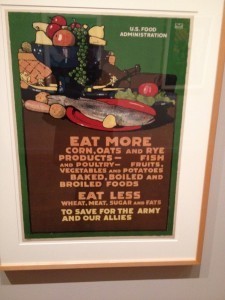 Kate Flora here, hoping you won’t tell anyone that I’m sitting at my desk. You see, because we have such an awful habit of always being at our desks, this week, my husband Ken and I declared ourselves to be on “Staycation.” This means that instead of drifting back to the keyboard to work, reading blogs, catch up on news, visit Facebook, or work (I have to mention work twice because work is what we’re generally doing) we are spending time together, and working at having fun.
Kate Flora here, hoping you won’t tell anyone that I’m sitting at my desk. You see, because we have such an awful habit of always being at our desks, this week, my husband Ken and I declared ourselves to be on “Staycation.” This means that instead of drifting back to the keyboard to work, reading blogs, catch up on news, visit Facebook, or work (I have to mention work twice because work is what we’re generally doing) we are spending time together, and working at having fun.
Okay, I can hear your sniggering. The chorus of cynical voices asking, “Seriously? You have to work at having fun?” But the answer is yes, we do. We have to remind ourselves, from time to time, that life is not a dress rehearsal and we can’t make up for lost time if we let too much of it slip away. We have to remember, in the words of our good friend Bea, that “fun is more fun.” We both love our work, but there’s some truth to the saying: All Work and No Play Makes Jack a Dull Boy. It makes Jill a dull Girl, too.
Sometimes the relationship needs to be nurtured; sometimes the well of creativity needs to be refilled. And it is a whole lot more affordable and easy to plan if the vacation doesn’t involve airplanes, weather, hotel reservations, rental cars, taxis, or packing.
Sunday afternoon we went to a chamber music concert. Last night we watched the pilot for Twin 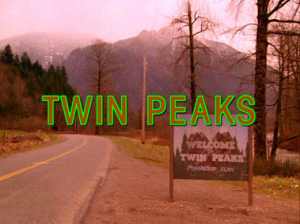 Peaks. Deliciously spooky. Then, making it a double feature, we watched Charlie Chaplin’s last movie, starring Marlo Brando and Sophia Loren, The Countess from Hong Kong, which was delightfully silly and fun. We ate salted nuts and chocolates. No one did a lick of work. Or mentioned calories or a healthy diet.
Peaks. Deliciously spooky. Then, making it a double feature, we watched Charlie Chaplin’s last movie, starring Marlo Brando and Sophia Loren, The Countess from Hong Kong, which was delightfully silly and fun. We ate salted nuts and chocolates. No one did a lick of work. Or mentioned calories or a healthy diet.
Today, we dragged ourselves away from keyboards and went to the Museum of Fine Arts in Boston. And the first thing we saw as we entered from the Fenway, was a wonderful exhibit of World War I posters. So great to be transported back to a time when the posters urged togetherness and shared sacrifice instead of selfishness and tuning out.
Also so great to see how much creativity and thought went into the design. How the designs are echoed in subsequent posters through the years. Doesn’t the one below conjure up images of Slim Pickens from Dr. Strangelove?
And how posters from England, France, Russia, and Germany are different from each other and very different from American posters.
Seeing an exhibit like this inspires curiosity and creating thinking in so many ways. It made me want to write books inspired by the posters. It made me feel proud to be American seeing the ways that people were pulled together. It made me want to redesign some of my book covers, or to think about the stories my future covers will tell in new ways.

We ran into friends at the museum and joined them for lunch. Another perk of the staycation? Without spending all that money on travel, we can indulge ourselves in dining out.
Staycation? So far, it’s working. Have you ever taken one? Where did you go?
December 1, 2014
December
 Hello again from Sarah Graves, writing to you from Eastport, Maine where the last rose of summer has created rose hips like those at left, as big and juicy as Bing cherries. I always plan to make rose hip jam and never quite do, mostly because those thorns do their job very swiftly and efficiently. And picking fruit while wearing big, thick, clumsy leather gloves just isn’t my cuppa, you know? But one of these years a little blessing will descend on my head, and then voila! (Or viola! as one of my favorite characters used to say.)
Hello again from Sarah Graves, writing to you from Eastport, Maine where the last rose of summer has created rose hips like those at left, as big and juicy as Bing cherries. I always plan to make rose hip jam and never quite do, mostly because those thorns do their job very swiftly and efficiently. And picking fruit while wearing big, thick, clumsy leather gloves just isn’t my cuppa, you know? But one of these years a little blessing will descend on my head, and then voila! (Or viola! as one of my favorite characters used to say.)
 This boat is painted boat-paint blue. When I first moved to Eastport there were a lot of little houses painted that color too, a real poke-in-the-eye hue that brought to mind the extra paint that must have been sitting around after the boat got its share. In Eastport, houses drink up lots of paint; the wind-driven salt air scours them clean, so we paint one side of the house per year unless we want the whole job all at once. And if you were unwise enough to sand the house down to the wood, then you exposed the old nails to air and you will never be free of rust stains again (don’t ask me how I know that…).
This boat is painted boat-paint blue. When I first moved to Eastport there were a lot of little houses painted that color too, a real poke-in-the-eye hue that brought to mind the extra paint that must have been sitting around after the boat got its share. In Eastport, houses drink up lots of paint; the wind-driven salt air scours them clean, so we paint one side of the house per year unless we want the whole job all at once. And if you were unwise enough to sand the house down to the wood, then you exposed the old nails to air and you will never be free of rust stains again (don’t ask me how I know that…).
 This old beauty has been sitting there for years, just waiting for someone to come along and rescue it. It’s a parts car now, I fear, unless the desire to rehab comes with a fat pocketbook. Every time I see it, I feel the prickly velvet-like upholstery of my grandfather’s car, which he drove very sedately unless it was time to “blow out the carburetor.” Then he took it out on a remote, rural northern Wisconsin road and let ‘er rip. Once he took my dad, who drove midget race cars, along for the ride. Dad came back pale and shaky and with a new respect for my shy, quiet grandfather.
This old beauty has been sitting there for years, just waiting for someone to come along and rescue it. It’s a parts car now, I fear, unless the desire to rehab comes with a fat pocketbook. Every time I see it, I feel the prickly velvet-like upholstery of my grandfather’s car, which he drove very sedately unless it was time to “blow out the carburetor.” Then he took it out on a remote, rural northern Wisconsin road and let ‘er rip. Once he took my dad, who drove midget race cars, along for the ride. Dad came back pale and shaky and with a new respect for my shy, quiet grandfather.
 This house is on a small island just across the bay from Eastport’s north end. There’s no road to it so if you want to go there you take the ferry and ask the ferry man to put in on the beach. If you want to get off the island, you go down to the beach when the ferry is coming by and wave, and the ferry comes in to pick you up. That’s how I heard it, anyway; probably the most reliable thing would be to have a vessel of your own, or a friend with one. However you get there, though, it strikes me as either a very good or very bad place to write a book.
This house is on a small island just across the bay from Eastport’s north end. There’s no road to it so if you want to go there you take the ferry and ask the ferry man to put in on the beach. If you want to get off the island, you go down to the beach when the ferry is coming by and wave, and the ferry comes in to pick you up. That’s how I heard it, anyway; probably the most reliable thing would be to have a vessel of your own, or a friend with one. However you get there, though, it strikes me as either a very good or very bad place to write a book.
 Here’s the cover of the UK ebook version of the first in the Home Repair is Homicide series, all of them now being published by our good friends at Mulholland Books. It’s completely thrilling to me that now someone in London or in Sydney, Australia will be able to read about Jake & the gang, almost like visiting those places myself, you know? Speaking of UK-related things, I am luxuriating lately in Dickens’ DAVID COPPERFIELD, so inventively plotted and wonderfully written that I can only hope some of its excellence might sink into me by osmosis. Every night I fall into it with pleasure and hope for it not to end….which it is in no danger of doing soon, I’m happy to report. Also reading: James Ellroy’s PERFIDIA. So good!
Here’s the cover of the UK ebook version of the first in the Home Repair is Homicide series, all of them now being published by our good friends at Mulholland Books. It’s completely thrilling to me that now someone in London or in Sydney, Australia will be able to read about Jake & the gang, almost like visiting those places myself, you know? Speaking of UK-related things, I am luxuriating lately in Dickens’ DAVID COPPERFIELD, so inventively plotted and wonderfully written that I can only hope some of its excellence might sink into me by osmosis. Every night I fall into it with pleasure and hope for it not to end….which it is in no danger of doing soon, I’m happy to report. Also reading: James Ellroy’s PERFIDIA. So good!
An Appreciation of Brian Katcher
Brian and I have never met, although we’ve exchanged emails a couple times. Still, we share a profession, that of librarianship. He’s a school librarian, I’m in the public sector. It’s clear from reading his blogging that he cares a great deal about helping kids ‘get’ it when it comes to information literacy and lighting the love of reading fire under them. We both have a sense of humor: Witness the about section from his website (Brian Katcher was born in St. Louis, Missouri, in 1975. He attended the University of Missouri, Columbia, before dropping out of society and bumming around Mexico for three years. He’s worked as a fry cook, a market researcher, a welding machine operator, a telemarketer (only lasted one day), and a furniture mover. He lived on an Israeli military base one summer, and once smuggled food into Cuba. When he’s not writing, he works as a school librarian. He lives in central Missouri with his wife and daughter. He still hasn’t paid the parking ticket he got in West Virginia in 1997.) (http://briankatcher.com/site/).

As near to a must read as there is.
I discovered him when I read the description for his second book, Almost Perfect which was published in 2010. I bought it, read it and added it to the collection here in Hartland, then added the audio edition as well. The book still resides in my head four years later, and from many of the reviews I’ve read, still does for many other readers. It’s about Logan who just discovered his girlfriend of three years has been cheating on him. He’s devastated, but when Sage, a breezy and cheerful, albeit mysterious new girl starts at his school and catches his eye, things begin to look up. Sage has been homeschooled for the past few years, hence nobody knowing anything about her. It doesn’t take long before Logan is completely captured by this new girl. It’s a huge shock when he discovers that Sage, while a girl in every way that should matter, was born a biological male and hasn’t gone through the physical transition.
Imagine that you’re an 18 year old who grew up in conservative Missouri, trying to wrap your head and emotions around something like this. Brian didn’t spare anything in crafting the rollercoaster of feelings that Logan and Sage experience. If there ever was a book that I wanted a sequel to, it was this one, but because of the story and the way it HAD to end, none could be written and that’s why it still lives in my head. I keep wondering where Sage and Logan’s lives are five years later. Very few book have ever had that effect on me.
When I finished it, I grabbed Brian’s first one, Playing With Matches, written in 2008. High school junior, Leon wonders why with so many females in the world, not a single one will even give him the time of day. Maybe it’s because he’s a nerdy D&D playing Monty Python addict with a penchant for telling bad jokes. When he tells Melody Hennon, a girl severely disfigured by a childhood burning accident a bad joke, she laughs, something nobody has ever seen her do. Despite his obsession with super attractive Amy Green, Leon finds himself opening up to Melody and she to him. He begins to see the equally beautiful and quirky girl hiding behind the burn scars.
When he saves Amy from detention, she shocks him and asks him to go out. How his response throws everything with both Melody and Amy into an interesting turmoil, one you need to discover for yourself by reading the book. (There are eleven copies in Maine libraries). A huge bonus in the book is the cast of supporting characters who are worth the price of admission on their own. Both this book and Almost Perfect would make terrific movies.
I had to wait another four years for Brian’s next book, but the wait was well worth it. Everyone Dies In The End…And I alone escaped to tell you came out in March. Imagine Leon six years later, only this time he’s morphed into seventeen year old Sherman Andrews, whose mom took off years ago, leaving him with his dad who’s a plumber. While Dad tries, he tends to be clumsy and a bit over-effusive, so Sherman created his master plan at age eight…Become an award winning investigative journalist which, at the moment, includes him getting as much as possible out of a summer school session at the Missouri Scholar’s Academy. Sherman is hoping a stellar performance this summer will open doors thanks to amazing recommendations from the professor he’s working with.

Hope it gets an Edgar nomination.
When he strikes up a conversation with Steph, an attractive girl in the lounge of the dorm while sorting through old files from the sociology department, a spider runs out of one, scaring her. Sherman swats it with the folder he’s holding and a yellowed letter flies loose. The moment he starts reading it, he’s hooked. It refers to a series of mysterious events in 1935 regarding something evil that four men, a minister, a college professor, a hobo and an army veteran joined forces to fight.
Steph is immediately forgotten as Sherman realizes he just might have found the holy grail for a budding investigative journalist. The next day, he goes to the historical society building, located near the campus library. Charlie, snarky, overweight and self-conscious, but with a brain and a sense of humor to match Sherman’s, is the sole person there, working as summer help. Their initial meeting goes like this:
“May I help you?”
The girl behind the counter was as young as Steph, shorter than Steph and probably weighed twice as much. She did, however, carry a lot of that weight in her chest, so it wasn’t necessarily a bad thing. She had hair as kinky as steel wool and as red as a box of McDonald’s french fries. A proliferation of freckles covered her apple cheeks. Thick lips and a turned-up nose completed the picture.
“Yes, um…” I glanced at her name plate. “Christine?”
“Call me Charlie.”
“Charlie, do you work here?” She seemed awfully young. I was hoping for someone a little more experienced to help me.
She raised an eyebrow. “No, I’m actually heiress to the throne of Moldavia. Today I switched places with a lowly peasant girl to see how the serfs live.” She then squinted her eyes and bared her teeth. It took me a moment to realize that this was how she smiled.
I found myself grinning in return. “Sarcasm. I learned about that in English Lit.”
“Yes, Einstein. I’ve worked here all summer. I’m going to be a freshman next year, so I figured I’d read all the books in advance. What’s your story?”
“Sherman. I’m a Youth Scholar.”
Thus begins a very unusual and quirky friendship that ends up being a lot more. In 98% of YA fiction, Charlie would be a blip on the main character’s radar, but like in Playing With Matches, we have the less than perfect girl who totally kicks ass. By the end of the book, pretty much anyone will have Charlie at the top of their way cool girls list.
Also like the aforementioned book, the supporting cast is pretty interesting. You get to meet the shadowy characters from 1935, Sherman’s asshat roommate, L.J. who grows a set when he needs them the most and isn’t deterred from helping Sherman even after an experience with a car chase that would send most teens running home to mama, and Denton, who was hauled off to a mental hospital after trying to investigate the same mystery that Sherman is looking into.
The bad guys are super bad, the mystery spans several centuries and the action is pretty much nonstop. The combination of quirky characters, evil, mystery and the romance between Sherman and Charlie make this a dandy read and one I sincerely hope garners a YA Edgar nomination because it’s that good.
I’m thrilled that Brian has another book coming out in May from Katherine Tegen Books. The Improbable Theory of Ana and Zak is described thusly: “When Ana Watson’s brother ditches a high school trip to run wild at Washingcon, type-A Ana knows that she must find him or risk her last shot at freedom from her extra-controlling parents.
In her desperation, she’s forced to enlist the last person she’d ever want to spend time with–slacker Zak Duquette–to help locate her brother before morning comes.
But over the course of the night, while being chased by hordes of costumed Vikings and zombies, Ana and Zak begin to open up to each other. Soon, what began as the most insane nerdfighter manhunt transforms into so much more…
The Improbable Theory of Ana and Zak is Brian Katcher’s hilarious he said/she said romance about two teens discovering themselves on an out-of-this-world accidental first date.”

Where’s my time machine when I really need it?
I can’t wait!
November 28, 2014
Online Holiday Shopping Tips
Jayne Hitchcock here – I was asked to speak at a local library recently about safe online shopping over the holidays and thought I’d share with you what I shared with them.
The first question I always get asked is “Is it safe?” Yes, it is! You’re more likely to have your credit card number or identity stolen offline than online.
The FTC found in 2013 that an average of 14% of consumers were victims of identity theft*
Only 2% were related to Internet services
These included misuse of credit card(s), misuse of social security number(s), misuse of victim’s name to rent an apartment, get medical care, a loan, etc.
Using your credit card online is safer in many respects
Think of it this way: When you give a waiter/waitress your credit card, then they walk away to a cash register – do you know what they’re doing with your card?
The same goes with retail clerks – they could easily turn around with your credit card in hand, and swipe it through a reader that they can later download to a computer, then use or sell the credit card number.
If a store or restaurant still uses carbon copies (and some still do), they keep one – what’s to stop an employee from writing down your credit card number?
Shopping online is easy and safe – if you know what to look for:
Try to use one credit card if you can to make all your online purchases
If something does happen, it’s much easier to cancel one card than to have to chase down several (which happens often offline)
Know the merchant you are purchasing from
If a merchant has their “storefront” on a free web hosting site, think twice unless you know them well
Check shipping rates and return policies
Check delivery time estimates
How Can You Tell If A Web Site Is Safe To Shop?
Many web sites use Secure Sockets Layer (SSL) technology to encrypt the credit card information that you send over the Internet. These sites usually inform you they are using this technology.
A different security technology is Secure Electronic Transaction, or SET. SET or SSL technology are designed to make your connection secure.
Or check the web browser you are using as follows:
In MS Internet Explorer, on the left is what you see when you are shopping online. Look at the web site address bar and notice it reads http://dailysteals.com. Once you put an item into your shopping cart, it should look like the right, with an “s” inserted to read https://dailysteals.com. The “s” means it is secured.
If you don’t see it as being secure, get out of there and find another site to shop at.
If you have the experience of a transaction gone wrong:
Try resolving the situation with the merchant via e-mail and a phone call
If that doesn’t work, call your credit card company or bank and dispute the charge(s)
File a complaint with the BBB online in the state where the merchant is located (bbbonline.org)
File a complaint with the FTC online (www.ftc.gov/ftc/consumer.htm)
Some other things to look out for:
If someone asks for your checking or savings account number, do NOT give it to them
Make sure to check all the charges before checking out
If the merchant asks you to transfer money into their banking account or wire it via Western Union, DO NOT do that
When you visit a company’s website, an unauthorized pop-up screen created by an identity thief could appear, with blanks for you to provide your personal information. Legitimate companies don’t ask for personal information via pop-up screens.
Keep documentation of your order. When you’ve completed the online order process, there may be a final confirmation page and/or you might receive confirmation by email. Print or save that information and keep it handy in case you need it later.
A lot of online merchants are offering free shipping, deep discounts , BOGO (Buy One Get One Free), and some even offer free gift wrapping. When you go onto a site, look around to see if there are any discounts or other things you can take advantage of.
A lot of the major sites have a “Deal of the Day,” such as Best Buy, K Mart, Wal Mart, Amazon.com, Sears and many others. I check those out just about every day and have snagged some great deals.
Some of my other favorites are:
Happy shopping!
November 27, 2014
Thanksgiving Leftovers: Corn and Turkey Chowder
Hi All. Barb here.

Thanksgiving Dinner–After
I hope yesterday you had a lovely day. We did. We spent the holiday at my husband’s sister’s house with most of my husband’s five siblings and spouses, along with assorted nieces, nephews, in-laws, outlaws and friends. It’s always a lovely day and the food, contributed by everyone, is delicious.
But I have to admit that my favorite part of Thanksgiving dinner is the leftovers. To wit:
Pie for breakfast: Pie, particularly apple or pumpkin, is the perfect breakfast food, a special treat after a holiday or other special occasion.

Desserts–Before
A turkey sandwich: I prefer mine cold, with mayo, stuffing, cranberry, and dark meat. On toasted white, or even better, scali bread. My husband cooks the “second turkey” for our celebration, and part of the reason to have one is to make sure everyone goes home with leftovers.
My grandmother’s Corn and Turkey Chowder: I grew up all my life with this dish. Initially, my father’s mother made it, then my mom took over, and now I do it.
This year, I thought we were out of luck, because my husband, a relentless experimenter, is doing a de-boned turkey. (You cook it over the stuffing, which gives the flavors of the turkey to the stuffing without the dangers of having it in the bird–at least allegedly.) So I’d written off the corn and turkey chowder. But my husband got to the butcher before they’d de-boned the bird, and was offered the carcass–so we’re back on.

Desserts–After
It’s a hearty soup, so chuck in plenty of turkey meat. However, as a child and into adulthood, I never, ever ate this meal without someone from one of the previous two generations saying, “When we made this during the Depression, there was never any meat left on the turkey bones. You kids don’t know how good you have it.”
They were right, of course. We probably don’t, but we certainly can appreciate how lucky we are to share this satisfying dish.
Here is the recipe, exactly as my mother wrote it down for me.
Corn and Turkey Chowder
Day One
Break turkey carcass into as small pieces as you can–include skin. Cover with water–two quarts will usually do it. Add a regular cooking onion with the skin on it, stuck with three or four cloves. Bring to a boil and simmer with lid partway on, an hour to an hour and a half. Pick out large pieces of carcass and strain the rest into a big bowl. Pick useable meat off the carcass and out of the strainer and add it to the broth in the bowl. Refrigerate overnight. Throw out bones.
Day Two
Remove fat from top of broth.
If only making for a few, divide broth and meat and freeze half for later use.
Put other half back in pot.
Add 1/3 to 1/2 bag of frozen chopped onions. Bring to a simmer.
Add
two cans of creamed corn
one can of niblet corn
one can of evaporated milk.
salt and pepper to taste.
You can use the remaining frozen turkey base to make turkey soup or you can make another batch of corn and turkey chowder later.
When making for a lot of people, use whole base, increase both kinds of corn, onion and evaporated milk. You sort of learn by doing. You want a substantial dish out of this. If you think you have too much broth, boil it down a little before adding the other ingredients.
Serve with a crusty bread.
Enjoy!
November 26, 2014
As We Gather Together . . .
As we all celebrate Thanksgiving with our families, as perhaps you are doing with yours, we thought we’d share some of our Thanksgiving memories, recipes, and thoughts (positive and negative) about togetherness.
Kaitlyn Dunnett: Here’s a picture for the Thanksgiving post, an illustration of the two things that I learned early on (age thirteen months in this photo) to associate with the holiday—family and food. Both sets of grandparents and my mom are in the picture, which was taken by my father. The same combination of family and food pretty much still holds true today. We gather the family around the table to pig out on turkey and all the fixings while catching up on what everyone’s been doing. I don’t remember any other traditions from when I was a kid, but nowadays when we get together with my husband’s family at Thanksgiving there is always a giant ceramic turkey on the table . . . filled with jelly beans. This year I’ll have to remember to ask how that tradition got started.
Lea Wait: Sorry, friends, but Thanksgiving has never been my favorite holiday. On too many

Waiting for someone with a carving knife
occasions when I was a child it ended up in emergency room visits: both my father and my uncle cut themselves (different years) with carving knives. And blood splattered turkey … well, maybe there are reasons I became a mystery writer! Once icy roads resulted in a car accident. No one was hurt, but the car (and Thanksgiving joy) were totaled. My Grandmother had a stroke on Thanksgiving. And one year, when I was all grown up and living in New York’s Greenwich Village, I spent Thanksgiving wrapped in blankets in a cold apartment (boiler problems) with a high fever. Memorable, for sure. And then, finally, when I moved to Maine full-time with my mother, who was disabled, we decided that since there would only be two of us for Thanksgiving I would roast a chicken instead of a turkey. And Thanksgiving Day the stove died. We had cold vegetables and a pie I’d baked the day before. Not a total disaster … but very depressing. This year my husband and I are hoping Wednesday’s predicted storm will leave us with power. And although I’m planning to serve sherry-creamed white onions, and turkey with stuffing, and potatoes mashed with feta cheese and cream, and an apple/blueberry pie …I’ve made sure we have cans of tuna fish as backup. Just in case. After all — it will be Thanksgiving! Hope your Thanksgiving is wonderful!

Sara Lloyd’s signature pie: cherry-raspberry
John Clark: When I think of Thanksgivings past, I remember how each family member had their specialty. Our late sister Sara was the champion baker. Her pies were to die for. Another tradition that I need to resurrect are squash rolls. Made by substituting a cup of squash for one of flour, when they’re made right, they can be a meal unto themselves. The other tradition, exclusively mine after my father died, was going out hunting before the meal was served. In the days during and after high school, there were more hunters out on Thanksgiving than any other day, something no longer the case. We had an old pump house on the north side of our orchard. It was a perfect spot to be in when other hunters worked the Teal Place, as we called the property adjoining Sennebec Hill Farm. I was sitting there lost in thought one Thanksgiving day over 25 years ago, when I heard a couple shots down by the swamp. I waited, waited a bit more and decided whatever the other guy spotted had been dropped or was headed up the ridge on the back side of the swamp toward Hope. Thirty seconds later, something that sounded like an express train started coming through the woods behind the pump house. When that buck hit the open field, I was so stunned by his size and rack, I didn’t realize I was holding a gun until he was entering the woods on the opposite side. I haven’t seen a deer anywhere near his size since and probably never will, but I still have that video stored in my head.
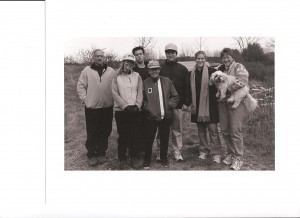 Kate Flora: What I remember most vividly, probably because it scandalized my father to the core of his conservative, small-town New England self, was when my mother got sick of all the women being stuck in the kitchen cooking and then stuck in the kitchen again cleaning up, and handed out numbers to all the relatives. Number one washed dishes, number two dried, then numbers three and four took their places, and so forth until everything was done. Great fun for her, I’m sure, to see the portly uncles and prim old aunts swathed in aprons and up to their elbows in soapy water. I am making sister Sara’s Raspberry-Cherry Pie for dinner. And of course, we always had mom’s raw cranberry relish. Super Easy Cranberry Relish: 1 bag of cranberries, washed and sorted 1 large orange 1 Red delicious apple, cored, not peeled Cut into chunks and throw in the food processor. Stir and add sugar to taste. Best if made the day before, to let the flavors mellow.
Kate Flora: What I remember most vividly, probably because it scandalized my father to the core of his conservative, small-town New England self, was when my mother got sick of all the women being stuck in the kitchen cooking and then stuck in the kitchen again cleaning up, and handed out numbers to all the relatives. Number one washed dishes, number two dried, then numbers three and four took their places, and so forth until everything was done. Great fun for her, I’m sure, to see the portly uncles and prim old aunts swathed in aprons and up to their elbows in soapy water. I am making sister Sara’s Raspberry-Cherry Pie for dinner. And of course, we always had mom’s raw cranberry relish. Super Easy Cranberry Relish: 1 bag of cranberries, washed and sorted 1 large orange 1 Red delicious apple, cored, not peeled Cut into chunks and throw in the food processor. Stir and add sugar to taste. Best if made the day before, to let the flavors mellow.
Vicki Doudera: Here is one dish we will be bringing to Thanksgiving at my brother Will’s home in

Hoover and the sprouts
Portland. I pick the Brussels sprouts fresh from my garden in the morning — they are the only thing still growing! These amounts can be adjusted to your liking.
Brussels Sprouts with Pistachios and Pancetta
5 cups Brussels sprouts, trimmed and big ones cut in half
1 cup pistachio nuts, shelled
2/3 cup diced pancetta
Few squirts of fresh lemon juice
few tablespoons olive oil
Half a cup diced shallots
Preheat oven to 350 degrees. Heat oil in cast iron skillet, add pancetta and cook until golden brown. Remove to plate lined with paper towels. Add more oil if necessary and sauté shallots until soft. Add Brussels Sprouts and cook until edges are browning. Cover skillet with foil and roast in oven for 15 minutes or so. Uncover and roast until cooked through. Drizzle with lemon juice, add nuts and pancetta and stir.
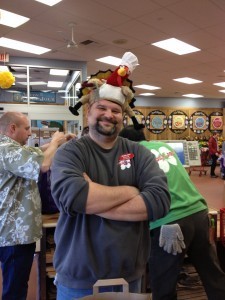
Genial checkout guy at Trader Joes
Susan Vaughan: Here is my Reduced Fat Pumpkin Pie recipe. My husband loves this pie, devours it every Thanksgiving with no clue it’s a “diet” recipe. Happy Thanksgiving!
REDUCED FAT PUMPKIN PIE 1/8 pie slice = 250 calories (egg whites recipe), 5 g fat
3 eggs or 4 egg whites
1 can (14 oz) Fat Free Sweetened Condensed Milk
1tsp cinnamon
½ tsp ginger
1 can pumpkin
¼ tsp nutmeg
1/8 tsp cloves
½ tsp salt
9 inch unbaked pie crust
In large bowl, beat eggs slightly. Add pumpkin, spices, salt. Slowly add milk. Mix well. Pour into pie shell. Bake at 425 for 15 minutes. Reduce heat to 350 and bake 25-30 minutes longer or until knife comes out clean.
November 25, 2014
How My Editor Changed My Book … and My Household
Lea Wait, cat owner, here.
When I was a young child my mother had a pair of Siamese cats. But I was a sickly kid, and after one life-threatening asthma attack the doctor proclaimed I was allergic to cats. My mother’s cats sadly disappeared, and we never had another one, fearing I’d either have health problems … or, perhaps even worse, by the time I did have problems (I knew I wasn’t immediately allergic to cats) my family would have become very attached to the cat.
But I write cozy mysteries. And for some reason, cats and cozies go together. In the Shadows Antique Print Series I gave my protagonist, Maggie Summer, a cat named Winslow Homer. Winslow wasn’t around much, but he was there.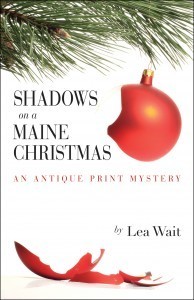
Then, last January, on a Maine day with snow billowing outside my window, the editor for my new (Mainely Needlepoint) mystery series called. I immediately panicked. The manuscript for TWISTED THREADS, the first in that series, wasn’t due until March 1 – and it wasn’t finished. What if he wanted it early? I could be in big trouble.
But our conversation took an unexpected turn.
Editor: I just called to see if there was a cat in TWISTED THREADS.
Me: (thinking fast.) No. Should there be a cat?
Editor: (who is always right) Cats are good.
Me: Then there’ll be a cat.
Editor: What does the cat look like?
Me: Ah … how about a Maine coon cat?
Editor: Great!
Me: (Getting a few more words in) Why do you need to know about the cat now?
Editor: Because the art department is working on the cover of TWISTED THREADS.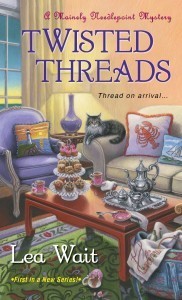
Okay. I was impressed that they were working on the cover of a book no one (including the author) had read yet. But — publishers do unexpected things. So I went back to my manuscript and gave Gram, the protagonist’s grandmother and major series character, a cat named Juno. (She’s the queen of the household.) And I finished the book. (You can see the cover. Juno may have come late to the cast of TWISTED THREADS, but she’s clearly the star.)
But — I’ll admit — I had trouble writing Juno in at appropriate moments. Having never had a cat, I wasn’t absolutely sure how she’d react to various scenes. Research was clearly needed. So … I started looking more closely at all those cute cat videos people post on Facebook.
But research should be primary, right? So I found myself thinking about getting a cat. I knew there might be a problem, should my allergies pop up again. But it turned out my husband liked cats almost as much as dogs. (We don’t have one of those, either.) And he was willing to take the risk.
 Cynthia Lord, one of my author friends, volunteers at the Coastal Humane Society, not far from us. (Among other books, she writes a wonderful series for young readers called the Shelter Pet Squad series. Write what you know!)
Cynthia Lord, one of my author friends, volunteers at the Coastal Humane Society, not far from us. (Among other books, she writes a wonderful series for young readers called the Shelter Pet Squad series. Write what you know!)
So when Cindy posted that the Humane Society was having a special adoption night June 1, my husband and I ended up there, at midnight, in the building where there were cats and kittens. Maybe we’d adopt an older cat, we thought. Maybe even two, if they were friends. To our amazement, when we got to the building an hour before midnight (when they would start placing the animals in homes) we were assigned number 27. People of all ages were there to meet the cats at midnight.
Feeling a bit crazy, we waited it out — still saying “maybe yes; maybe no.” Then, finally, close to 1 in the morning, it was our turn. As we walked into the area where the caged cats were, my husband casually said, “I’ve always liked black cats.” Who knew? And so while I was oohing at the kittens (although we were there, you understand, to adopt an older cat,) Bob went from one cage to another, talking to the black cats. “Com’on out, boy. No one’ll adopt you if you’re in the back of the cage!”
A mystery writer with a black cat. Okay. That sounded interesting.
As we worked our way around the room it was clear kittens had become a possibility. And then, over in the far corner, we came to a cage holding two black kittens. One already wore the little necklace the Humane Society put on “chosen animals.” But the other? Bob opened the cage and took her out. She immediately jumped to his shoulder and nestled there. And he said, “We’ve found our cat.”

Bob & I & Shadow the night we adopted her
So — I share custody of a now eight-months old black cat named Shadow. Yes, Juno is also in the books following TWISTED THREADS. And my main character, Angie Curtis, may even get a cat of her own in a book or two.
Shadow has changed our lives in ways we couldn’t have imagined. More on that in a future post.,
But, for now, allergy-free (knocking on wood,) thanks to an editor in New York, thousands of readers who love cats in mysteries, and a friend who volunteers at the Humane Society … for the first time in my life I own a cat.
Although — as I’ve seen on FB — maybe that cat now owns me.
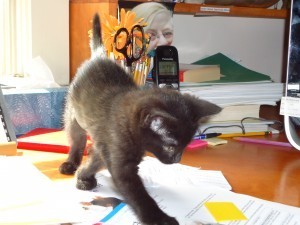
Shadow, age 2 months, helping me write
Lea Wait's Blog
- Lea Wait's profile
- 509 followers


